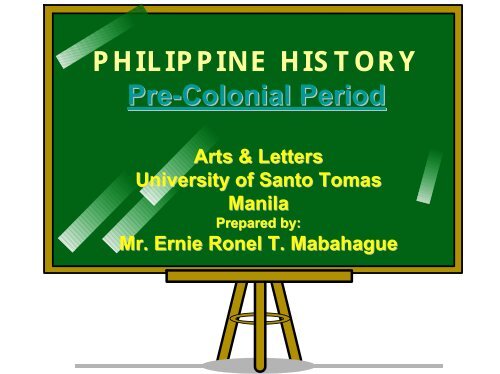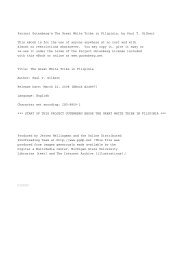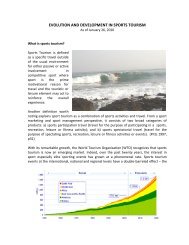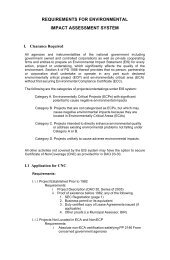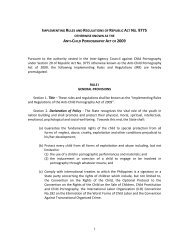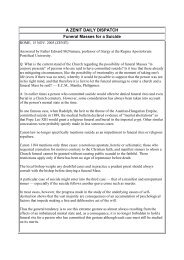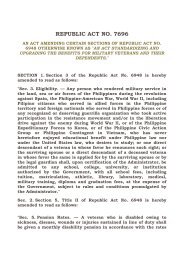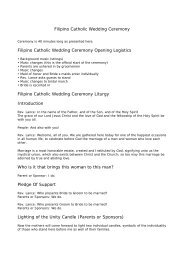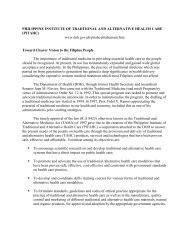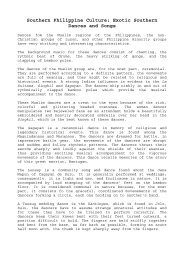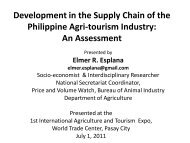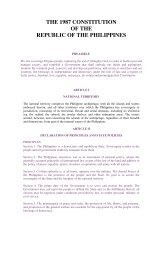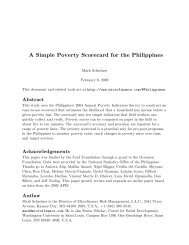PHILIPPINE HISTORY Pre-Colonial Period - Philippine Culture ...
PHILIPPINE HISTORY Pre-Colonial Period - Philippine Culture ...
PHILIPPINE HISTORY Pre-Colonial Period - Philippine Culture ...
You also want an ePaper? Increase the reach of your titles
YUMPU automatically turns print PDFs into web optimized ePapers that Google loves.
<strong>PHILIPPINE</strong> <strong>HISTORY</strong><br />
<strong>Pre</strong>-<strong>Colonial</strong> <strong>Period</strong><br />
Arts & Letters<br />
University of Santo Tomas<br />
Manila<br />
<strong>Pre</strong>pared by:<br />
Mr. Ernie Ronel T. Mabahague
<strong>Pre</strong>-<strong>Colonial</strong> <strong>Philippine</strong>s<br />
A.<br />
Society<br />
1.<br />
2.<br />
3.<br />
4.<br />
5.<br />
6.<br />
Mode of Dressing<br />
Ornaments<br />
Houses<br />
Social Classes<br />
Status of Women<br />
Marriage customs<br />
7. Mixed Marriages, Inheritance and<br />
Succession
<strong>Pre</strong>-<strong>Colonial</strong> <strong>Philippine</strong>s<br />
B. Politics<br />
1. Government<br />
2. Laws<br />
3. Legislation<br />
4. Judicial Process<br />
5. Trial by Ordeal<br />
C. Religion<br />
1. Religious<br />
Beliefs<br />
2. Burial<br />
3. Divination<br />
and Magic<br />
Charms
<strong>Pre</strong>-<strong>Colonial</strong> <strong>Philippine</strong>s<br />
D. Economic Life<br />
1. Agriculture<br />
2. Livestock<br />
3. Fishing<br />
4. Mining<br />
5. Lumbering and<br />
Shipbuilding<br />
6. Weaving<br />
7. Trade<br />
E. <strong>Culture</strong><br />
1. Languages<br />
2. System of<br />
Writing<br />
3. Literature<br />
4. Music and<br />
Dance<br />
5. Art
Long before the Spaniards came to the<br />
<strong>Philippine</strong>s, Filipinos had a civilization of<br />
their own. This civilization partly came<br />
from the Malay settlers and partly from<br />
their response to the new environment.<br />
Many of these customs and traditions,<br />
government and way of life, have come<br />
down to the present day, despite the<br />
changes brought about by westernization<br />
and modernization. This is why it is<br />
possible to know about our distant past by<br />
simply observing some customs and<br />
practices that have resisted change and<br />
modernization.
Society<br />
<strong>Philippine</strong> pre-colonial society is both<br />
different and the same as in the present.<br />
Some aspects of the pre-colonial period<br />
have survived into our time. The following<br />
is a description of the way of life of precolonial<br />
Filipinos.
Bogobo man & woman<br />
Mode of Dressing<br />
Kalinga & subuanon women<br />
• male attire was composed of the<br />
kanggan (sleeveless jacket) and<br />
bahag (loincloth)<br />
• the color of the kanggan indicates<br />
rank – red for the chief, black or<br />
blue for the commoners<br />
• men also wear a turban called<br />
putong, which also tell the social<br />
status/achievement of the<br />
individual wearing it<br />
• female attire consisted of baro or<br />
camisa (jacket with sleeves) and<br />
saya or patadyong (a long skirt);<br />
some women wore a piece of red<br />
or white cloth on top of their skirt<br />
called tapis
putong<br />
Bogobo man
Ornaments<br />
• men and women wore ornaments to<br />
look attractive<br />
• both wear kalumbiga, pendants,<br />
bracelets, and leglets<br />
• these ornaments were made of gold<br />
• some wore gold fillings between the<br />
teeth<br />
• tattoos were also fashionable for some<br />
pre-colonial Filipinos; they also exhibit<br />
a man’s war record<br />
• Islas del Pintados – term coined by the<br />
Spaniards for the Visayans
Bontoc men
Houses<br />
• built to suit the tropical<br />
climate<br />
• called bahay kubo, made of<br />
wood, bamboo, and nipa<br />
palm; it was built on stilts and<br />
can be entered through<br />
ladders that can be drawn up<br />
• some Filipinos, such as the<br />
Kalingas, Mandayas and<br />
Bagobos built their houses<br />
on treetops<br />
• others, such as the Badjaos,<br />
built their houses on boats
Social Classes<br />
• the society was made up of<br />
three classes: nobles<br />
(made up of the datu and<br />
their families), mahadlika or<br />
maharlika (freemen) and<br />
the alipin (dependents)<br />
• members of the nobility<br />
were addressed with the<br />
title Gat or Lakan among<br />
the Tagalogs
• alipin or dependents acquired their status by<br />
inheritance, captivity, purchase, failure to settle<br />
debts, or by committing a crime<br />
• there were two kinds of dependents: aliping<br />
namamahay and aliping sagigilid<br />
• in the Visayas,<br />
dependents<br />
were of three<br />
kinds : tumataban,<br />
tumarampok, and<br />
the ayuey<br />
Maguindanao Sultan, nobles &<br />
Alipins
Status of Women<br />
• women in pre-colonial <strong>Philippine</strong> society<br />
had the right to inherit property, engage in<br />
trade and industry, and succeed to the<br />
chieftainship of the barangay in the<br />
absence of a male heir<br />
• had the exclusive right to name their<br />
children<br />
• men walked behind them as a sign of<br />
respect
Marriage customs<br />
• men were in general, monogamous; while their wives are<br />
called asawa, while concubines are called “friends”<br />
• in order to win the hand of his lady, the man has to show<br />
his patience and dedication to both the lady and her<br />
parents<br />
• courtship usually begins with paninilbihan<br />
• if the man wins the trust of the parents, he does not<br />
immediately marry the woman, but he has to satisfy<br />
several conditions:<br />
- give a dowry or bigay-kaya<br />
- pay the panghihimuyat<br />
- pay the wet nurse bigay-suso<br />
- pay the parents himaraw<br />
- bribe for the relatives called sambon (among the<br />
Zambals)
• once he had settled all of the above<br />
requirements, he brings his parents to meet with<br />
the bride-to-be’s parents to haggle and make<br />
the final arrangements; this is called<br />
pamamalae or pamamanhikan or<br />
pamumulungan<br />
• the wedding ceremonies vary depending on the<br />
status of the couple; but normally, those from<br />
the upper class, a go-between was employed<br />
• weddings are officiated by the priestess or<br />
babaylan<br />
• uncooked rice is thrown on the couple after the<br />
wedding ceremony
abaylan<br />
Go to Religious Beliefs
Tausog wedding<br />
ceremony<br />
Marriage ceremony - eating rice
• Muslim Filipinos have similar marriage customs; the<br />
first stage was called pananalanguni or bethrothal; it<br />
was followed by the consultation with the girl’s parents,<br />
who relays their decision to the village chief, who in<br />
turn informed the suitor’s parents of the decision<br />
• dowry was also settled by the chief (pedsungud). This<br />
was of seven kinds: 1. kawasateg, money given to the<br />
bride’s close relatives; 2. siwaka, brassware given to<br />
those who helped arrange the wedding; 3. enduatuan,<br />
brassware or animals for the village chief; 4.<br />
pangatulian, jewelry given to the bride’s mother and<br />
aunts; 5. tatas, blade given to the girl’s uncle; 6.<br />
langkad, money given to the girl’s parents as fine for<br />
having bypassed the girl’s elder sister if she had any;<br />
and 7. lekat, amount of money given to the girl’s<br />
attendant.
• once everything is settled, the pegkawing, or the<br />
wedding ceremony follows<br />
• the wedding ceremony is officiated by the hadji<br />
• six days of festivities followed, and only on the<br />
seventh day could the couple sleep together<br />
Muslim<br />
wedding
Mixed Marriages, Inheritance and Succession<br />
• mixed marriages were allowed in pre-colonial<br />
society<br />
• the status of children were dependent upon the<br />
status of the parents<br />
• often, the status of children in mixed marriages<br />
is divided evenly between the parents<br />
• single children of mixed marriage were half-free<br />
and half-dependent<br />
• legitimate children inherited their parents’<br />
property even without any written will and was<br />
divided equally among the children
• natural children inherited only a third of the<br />
inheritance of legitimate children<br />
• children of dependent mothers are given<br />
freedom and a few things<br />
• nearest relatives inherit the property of<br />
childless couples<br />
• in succession, the first son of the barangay<br />
chieftain inherits his father’s position; if the<br />
first son dies, the second son succeeds<br />
their father; in the absence of male heirs, it<br />
is the eldest daughter that becomes the<br />
chieftain
Politics
Government<br />
• unit of government was the barangay,<br />
which consisted of from 30 to 100 families.<br />
The term came from the Malay word<br />
balangay, meaning boat<br />
• barangays were headed by chieftains<br />
called datu<br />
• the subjects served their chieftain during<br />
wars, voyages, planting and harvest, and<br />
when his house needs to be built or<br />
repaired; they also paid tributes called<br />
buwis
alangay
• the chief or datu was the chief executive, the<br />
legislator, and the judge; he was also the<br />
supreme commander in times of war<br />
• alliances among barangays were common and<br />
these were formalized in a ritual called<br />
sangduguan<br />
• conflicts between or<br />
among barangays<br />
were settled by<br />
violence; those who<br />
win by force is<br />
always right
Laws<br />
• were either customary (handed down from<br />
generation to generation orally) or written<br />
(promulgated from time to time as necessity<br />
arose)<br />
• dealt with various subjects such as inheritance,<br />
property rights, divorce, usury, family relations,<br />
divorce, adoption, loans, etc.<br />
• those found guilty of crimes were punished either<br />
by fine or by death; some punishments can be<br />
considered as torture by modern standards<br />
• however, it must be noted that ancients did not<br />
believe in endangering society by letting loose a<br />
gang of thieves of recidivists who are incapable<br />
of reform
Legislation<br />
• before laws are made, the chief consults<br />
with a council of elders who approved of<br />
his plan<br />
• they are not immediately enforced until the<br />
new legislation is announced to the village<br />
by the umalohokan, who also explains the<br />
law to everyone
Judicial Process<br />
• disputes between individuals were settled by a<br />
court made up of the village chief and the<br />
council of elders; between barangays, a board<br />
made up of elders from neutral barangays acted<br />
as arbiter<br />
• the accused and the accuser faced each other in<br />
front of the “court” with their respective<br />
witnesses<br />
• both took an oath to tell the truth; most of the<br />
time, the one who presents the most witnesses<br />
wins the case<br />
• if the losing party contests the decision, he is<br />
bound to lose in the end because the chief<br />
always take the side of the winner
Trial by Ordeal<br />
• to determine the innocence of an accused,<br />
he is made to go through a number of<br />
ordeals which he must pass<br />
• examples include dipping one’s hand in<br />
boiling water, holding a lighted candle that<br />
must not be extinguished, plunging into a<br />
river and staying underwater for as long as<br />
possible, chewing uncooked rice and<br />
spitting, etc.<br />
• among the Ifugaos, ordeal by combat was<br />
common, i.e. bultong (wrestling), alaw (duel)
ultong
Religion
Religious Beliefs<br />
• pre-colonial Filipinos believed in the immortality<br />
of the soul and in life after death<br />
• they also believed in the existence of a number<br />
of gods whom they worship and made offerings<br />
to according to rank<br />
• i.e. Bathalang Maykapal (Creator), Idinayale<br />
(god of agriculture), Sidapa (god of death),<br />
Balangaw (rainbow god), Mandarangan (war<br />
god), Agni (fire god) Lalahon (goddess of<br />
harvest), Siginarugan (god of hell), Diyan<br />
Masalanta (goddess of love), etc.
Bathala<br />
Agni (India)
• also showed respect for animals and<br />
plants like the crocodile, crow,<br />
tigmamanukin; some trees were not also<br />
cut because they were thought to be<br />
divine<br />
• diseases were thought to be caused by<br />
the temper of the environmental spirits<br />
• Filipinos also venerated the dead by<br />
keeping alive their memory by carving<br />
idols of stone, gold or ivory called likha or<br />
larawan; food, wine and other things were<br />
also shared with the dead
• adored idols called anitos or diwatas to<br />
whom they made offerings<br />
• some anitos were considered bad;<br />
however, they made offerings to them too<br />
in order to appease them or placate their<br />
anger<br />
• priestesses such as the babaylan/ baylana<br />
or katalona acted as mediums to<br />
communicate with these spirits
Burial<br />
• the dead was placed in a wooden coffin<br />
and buried under the house complete with<br />
cloth, gold and other valuable things<br />
• upon the death of the person, fires were<br />
made under the house and armed men<br />
acted as sentinels to guard the corpse<br />
from sorcerers<br />
• professional mourners were hired to<br />
accentuate the depth of mourning
• sometimes, the relatives of the dead wore<br />
rattan bands around their arms, legs and<br />
necks and they abstained from eating<br />
meat and drinking wine<br />
• the ancients distinguished mourning for a<br />
woman from that of a man – morotal (for<br />
women) and maglahi (for men)<br />
• mourning for a dead chief is called laraw,<br />
and this was accompanied by certain<br />
prohibitions like engaging in petty quarrels,<br />
wars, carrying daggers with hilts in the<br />
normal position, singing in boats coming<br />
from the sea or river, and wearing loud<br />
clothes
• some ancients fasted and limited their<br />
nutrition to vegetables; among the<br />
Tagalogs, this is called sipa<br />
• relatives of the dead who was murdered<br />
would not end their mourning until they<br />
have exacted vengeance or balata<br />
• the celebration held on the ninth night after<br />
the death of the person is called pasiyam,<br />
in which a play called tibaw is staged to<br />
honor the dead
Divination and Magic Charms<br />
• ancient Filipinos are quite superstitious<br />
and put much stock into auguries, and<br />
magic charms<br />
• they interpreted signs in nature like the<br />
flight of birds, the barking of dogs, the<br />
singing of lizards, and the like, as good or<br />
bad omens depending on the<br />
circumstances<br />
• they also consulted with the pangatauhan,<br />
or soothsayers, to tell their fortunes
• there was also a belief in the existence of<br />
the aswang, mangkukulam,<br />
manggagaway, tiyanak, and the tikbalang<br />
• amulets and charms were also used by<br />
the ancients like the anting-anting,<br />
gayuma, odom or tagabulag, wiga or<br />
sagabe, and tagahupa<br />
• these beliefs were not eradicated with the<br />
coming of Western civilization and most of<br />
them were practiced behind the backs of<br />
the Christian missionaries<br />
• the result was a blending of pagan and<br />
Christian beliefs that made Filipino<br />
Catholicism unique
Economic<br />
Life
Agriculture<br />
• main source of livelihood<br />
• rice, coconuts, sugar cane, cotton, hemp,<br />
bananas, oranges, and many species of<br />
fruits and vegetables were grown<br />
• done in two ways : kaingin system (slash<br />
and burn) and tillage<br />
• when the Spaniards came to the<br />
<strong>Philippine</strong>s, they noted that Cebu and<br />
Palawan were abundant in many<br />
agricultural foodstuffs
• agricultural productivity was enhanced<br />
by use of irrigation ditches like those<br />
found in the Ifugao Rice Terraces<br />
• landholding was either public (less<br />
arable land that could be tilled freely<br />
by anyone) and private (rich and<br />
cultivated lands belonging to nobles<br />
and datus)<br />
• some rented land and paid in gold or in<br />
kind
• the daily fare consisted of rice and boiled<br />
fish, or sometimes pork or venison,<br />
carabao or wild buffalo meat<br />
• fermented the sap of palm trees and drank<br />
it as liquor called tuba<br />
Livestock<br />
• <strong>Pre</strong>-colonial Filipinos raised chickens,<br />
pigs, goats, carabaos, and small native<br />
ponies
Fishing<br />
• was a thriving industry for those who live<br />
in the coast or near rivers and lakes<br />
• various tools for fishing such as nets, bow<br />
and arrow, spear, wicker basket, hooks<br />
and lines, corrals and fish poisons were<br />
used<br />
• pearls fisheries also abound in Sulu
Fishing<br />
with bow<br />
& arrow<br />
Mining<br />
• comparatively developed before the coming of the<br />
Spaniards<br />
• the ancients mined gold in many parts of the archipelago<br />
and were traded throughout the country and with other<br />
countries
Lumbering and Shipbuilding<br />
• were flourishing<br />
industries<br />
• Filipinos were said to be<br />
proficient in building<br />
ocean-going vessels<br />
• all kinds of boats or<br />
ships were built, which<br />
the Spaniards later call<br />
banca, balangay, lapis,<br />
caracoa, virey, vinta and<br />
prau
Weaving<br />
• home industry<br />
that was<br />
dominated<br />
by women<br />
• using crude<br />
wooden looms,<br />
textiles such as<br />
sinamay from hemp, medrinaque from<br />
banana, cotton, linen, and silk, were woven
Trade<br />
• was conducted between or among barangays,<br />
or even among the islands<br />
• there was trade too with other countries such as<br />
China, Siam, Japan, Cambodia, Borneo,<br />
Sumatra, Java, and other islands of old Malaysia<br />
• did not use any currency but conducted trade<br />
through barter<br />
• sometimes, goods were priced in terms of gold<br />
or metal gongs<br />
• Chinese traders noted that Filipinos were very<br />
honest in their commercial transactions
<strong>Culture</strong><br />
<strong>Philippine</strong> pre-colonial culture was basically<br />
Malayan in structure and form. They had<br />
written language which was used not just<br />
for communication but also for literary<br />
expression. They also had music and<br />
dances for almost all occasions and a wide<br />
variety of musical instruments that shows<br />
their ingenuity.
Languages<br />
• there are more than one hundred<br />
languages in the <strong>Philippine</strong>s, eight of<br />
which are considered major languages.<br />
They are: Tagalog, Iloko, Pangasinan,<br />
Pampangan, Sugbuhanon, Hiligaynon,<br />
Samarnon or Samar-Leyte, and<br />
Magindanao
• these languages are descended from<br />
Austronesian or Malayo-Polynesian<br />
language<br />
• the differences might be accounted for the<br />
need to forming new words and phrases to<br />
fit the new environment<br />
• many of the words or terms in Filipino<br />
languages were derived from Malayan
System of Writing<br />
• before the arrival of the Spaniards,<br />
Filipinos used a syllabary which was<br />
probably of Sanskrit or Arabic provenance<br />
• the syllabary consisted of seventeen<br />
symbols, of which three were vowels and<br />
fourteen consonants<br />
• no one is certain about the direction of<br />
writing<br />
• Fr. Pedro Chirino’s theory is that the<br />
ancients wrote from top to bottom and<br />
from left to right
• pre-colonial Filipinos wrote on bark of<br />
trees, on leaves and bamboo tubes, using<br />
their knives and daggers, pointed sticks or<br />
iron as pens and the colored saps of trees<br />
as ink<br />
• only a few of this writings survive into the<br />
present because early Spanish<br />
missionaries destroyed many manuscripts<br />
on the ground that they are the work of the<br />
Devil himself<br />
• some pieces of literature, however, have<br />
been handed down to us orally
Laguna Copperplate Inscription<br />
By Hector Santos<br />
http://isanghamahal.blogspot.com/2006_03_01_archive.html<br />
Antoon Postma, a Dutch national who has lived most of his life among the Mangyans<br />
in the <strong>Philippine</strong>s and the director of the Mangyan Assistance & Research Center in<br />
Panaytayan, Mansalay, Oriental Mindoro, was able to translate the writing. His effort<br />
is all the more remarkable when you consider that the text was in a language similar<br />
to four languages (Sanskrit, Old Tagalog, Old Javanese, and Old Malay) mixed<br />
together…<br />
The text was written in Kavi, a mysterious script which does not look like the ancient<br />
Tagalog script known as baybayin or alibata. Neither does it look similar to other<br />
<strong>Philippine</strong> scripts still used today by isolated ethnic minorities like the Hanunóos and<br />
the Buhids of Mindoro, and the Tagbanwas of Palawan. It is the first artifact of pre-<br />
Hispanic origin found in the <strong>Philippine</strong>s that had writing on copper material…<br />
Postma's translation provides a lot of exciting surprises. Like most other copperplate<br />
documents, it gives a very precise date from the Sanskrit calendar which<br />
corresponds to 900 A.D. in our system. It contains placenames that still exist around<br />
the Manila area today. It also lists the names of the chiefs of the places mentioned.<br />
The placenames mentioned prove the <strong>Philippine</strong> connection of the LCI. The names<br />
are still recognizable today although almost eleven centuries have passed since the<br />
document was issued. The placenames are Pailah (Paila), Tundun (Tundo), Puliran<br />
(Pulilan), Binwangan (Binwangan), Dewata (Diwata), and Medang (Medang)…
Laguna copperplate inscription
Literature<br />
• pre-colonial literature may be classified into :<br />
floating or oral and written literature<br />
• Tagalogs have the bugtong (riddle), suliranin<br />
and indulanin (street songs), sabi (maxim),<br />
sawikain (saying), talindaw (boat songs), diyuna<br />
(song of revelry), kumintang (war song which<br />
evolved into a love song), dalit and umbay<br />
(dirge), tagumpay, balikungkong, dupayinin and<br />
hiliraw (war songs), uyayi and hele (lullabies),<br />
ihiman (bridal song), tagulaylay (mournful song),<br />
tigpasin (rowing song), tingad (household song),<br />
and kutang-kutang (couplets usually chanted by<br />
the blind)
• songs, dance and the drama probably<br />
developed simultaneously<br />
• most of the pre-colonial drama was held in<br />
the sambahan or places of worship<br />
• these dealt with various subjects including<br />
love, war, legends, the memory of the<br />
deceased, and war heroes
• dramas developed into different forms<br />
such as the pagbati, karagatan, tagayan,<br />
pananapatan, sabalan, and tibaw<br />
• the karagatan was a debate in verse in<br />
which a problem is resolved; it developed<br />
into the duplo during the Spanish period<br />
and then into the balagtasan in 1924<br />
during the American period<br />
• tibaw on the other hand is perform during<br />
the pasiyam
• Maranaw literature, inspired by Islam,<br />
consisted of tutul (folk tale), tubad-tubad<br />
(short love poems), pananaro-on (sayings<br />
and proverbs), sowa-sowa-i (drama),<br />
antoka (riddle or puzzle), and darangan<br />
(epic poetry)<br />
• Ilocano literature, for its part, has many<br />
kinds of songs sung on different<br />
occasions; this include dal-ot (song during<br />
baptismal party, wedding, or a feast),<br />
badeng (love song sung in a serenade),<br />
and dung-aw (dirge)
• Filipinos were fond of composing epic<br />
poetry, which is why the country is unique<br />
for having more than twenty epic poems.<br />
Examples of this are Hudhud and Alim<br />
(Ifugao), Biag ni Lam-Ang (The Life of Lam-<br />
Ang / Ilocano), Bantugan, Indarapatra at<br />
Sulayman, and<br />
Bidasari<br />
(Moslems)<br />
Igorots<br />
reciting<br />
Hudhud
Princess<br />
Lanawen<br />
to be won<br />
by Prince<br />
Bantugan<br />
Princess Bidasari story is like Snow White’s<br />
Indarapata &<br />
Sulayman
Music and Dance<br />
• Filipinos are naturally fond of both music<br />
and dance, and usually, whenever<br />
music is played, it is accompanied by<br />
dance
• some examples of pre-colonial musical<br />
instruments include kudyapi (Tagalog), bansic<br />
or a cane with four holes and gangsa or a small<br />
guitar (Negritos of Luzon), abafii a Malay music<br />
instrument (Igorots), gongs, Jews harp, bamboo<br />
flute, kutibeng or a guitar<br />
with five strings (Ilocano),<br />
kalaleng or a nose flute<br />
and diwdiw-as or pan<br />
pipe made of seven<br />
bamboos reeds<br />
(Tinguians)
• examples of the native dances, which<br />
depict different events include Potato<br />
Dance, Torture Dance, Duel Dance,<br />
Lovers Dance (Negritos); macasla dance<br />
(Tagbanua), kinnotan or ant’s dance and<br />
the kinnallogong or hat dance (Ilocano);<br />
balitaw and dandansoy (Visayan);<br />
balatong, dalit, hiliraw, kutang-kutang,<br />
lulay, indulanin, kumintang, salampati,<br />
tagulaylay, subli, barimbaw, and tagayan<br />
(Tagalog)
• this shows that Filipinos<br />
have songs and dances for<br />
almost all occasions and<br />
because of their frequent<br />
association, their social<br />
organization was more wellknit<br />
than it is today
Art<br />
• first glimpse can be seen in primitive tools<br />
and weapons that were polished along the<br />
lines of leaves and petals of flowers<br />
• can also be seen in beads, amulets,<br />
bracelets, and other ornaments made of<br />
jade, red cornelian, and other stones<br />
• dyed and ornamented their barkcloth with<br />
designs of attractive colors
• in the Iron Age, aside from armlets,<br />
bracelets, rings, and headbands, tattoos<br />
also became fashionable; metals and<br />
glass also came into use; weaving<br />
became a preoccupation for women;<br />
weapons were manufactured with designs<br />
on their handles; pottery with incised<br />
designs were made; and carvings made of<br />
wood, bone, ivory or horn were also done<br />
not only for the use of the living but also of<br />
the dead
Sarimanok<br />
utensils<br />
gangsa
• the zigszag designs on ancient lime tubes<br />
and the ornamental carvings on combs<br />
reflect Negrito influence<br />
• Indonesian influence can be seen in the<br />
apparel of the Kalingas, Maranaos,<br />
Manobos and Bagobos<br />
• Malay influence can be traced to the wood<br />
carvings found in utensils, boats, and<br />
wooden shields of the people of Sulu,<br />
Mindanao and Mountain Province
Igorot<br />
shields
• Islamic influence can be gleaned from the<br />
ornamental and decorative art of the<br />
Lanao Muslims; most represent geometric<br />
and plant designs because Islam is<br />
iconoclastic<br />
• Ifugao art deals with human and animal<br />
representations but not fish and plant<br />
forms; Ifugao art is functional
Igorot<br />
bamboo<br />
art
Sources<br />
• wikipedia.org<br />
• tribo.org<br />
• apat-na-alon-tribe.com<br />
• aenet.org<br />
• elaput.org<br />
• filipiniana.net<br />
• veimages.gsfc.nasa.gov<br />
• phivolcs.dost.gov.ph<br />
• kheper.net<br />
• msuiit.edu.ph<br />
• seasite.niu.edu<br />
• philippines.hvu.nl<br />
• kabayancentral.com<br />
• filipinoheritage.com<br />
• malignosrealm.netfirms.com<br />
• sinemamalaysia.com.my<br />
• sacred-texts.com/hin/iml/iml07.htm<br />
• reflectionsofasia.com/anting_anting.htm<br />
• gutenberg.org/files/12849/12849-h/12849-h.htm<br />
• isanghamahal.blogspot.com/2006_03_01_archive.html<br />
• geocities.com/sanduguan/maharlika/maharlika.htm<br />
• skyinet.net/~taomusic/gracenono/taofoundation.html


